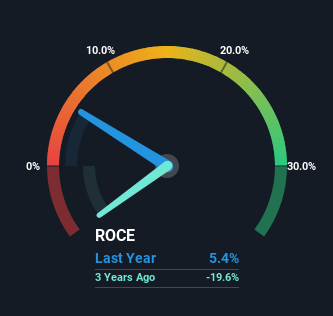- South Korea
- /
- Machinery
- /
- KOSE:A010140
Samsung Heavy Industries (KRX:010140) Is Looking To Continue Growing Its Returns On Capital

What are the early trends we should look for to identify a stock that could multiply in value over the long term? Firstly, we'll want to see a proven return on capital employed (ROCE) that is increasing, and secondly, an expanding base of capital employed. Put simply, these types of businesses are compounding machines, meaning they are continually reinvesting their earnings at ever-higher rates of return. So when we looked at Samsung Heavy Industries (KRX:010140) and its trend of ROCE, we really liked what we saw.
Return On Capital Employed (ROCE): What Is It?
For those that aren't sure what ROCE is, it measures the amount of pre-tax profits a company can generate from the capital employed in its business. Analysts use this formula to calculate it for Samsung Heavy Industries:
Return on Capital Employed = Earnings Before Interest and Tax (EBIT) ÷ (Total Assets - Current Liabilities)
0.054 = ₩233b ÷ (₩16t - ₩11t) (Based on the trailing twelve months to December 2023).
So, Samsung Heavy Industries has an ROCE of 5.4%. Ultimately, that's a low return and it under-performs the Machinery industry average of 7.0%.
Check out our latest analysis for Samsung Heavy Industries

In the above chart we have measured Samsung Heavy Industries' prior ROCE against its prior performance, but the future is arguably more important. If you'd like, you can check out the forecasts from the analysts covering Samsung Heavy Industries for free.
What Can We Tell From Samsung Heavy Industries' ROCE Trend?
We're delighted to see that Samsung Heavy Industries is reaping rewards from its investments and has now broken into profitability. The company was generating losses five years ago, but now it's turned around, earning 5.4% which is no doubt a relief for some early shareholders. In regards to capital employed, Samsung Heavy Industries is using 46% less capital than it was five years ago, which on the surface, can indicate that the business has become more efficient at generating these returns. This could potentially mean that the company is selling some of its assets.
For the record though, there was a noticeable increase in the company's current liabilities over the period, so we would attribute some of the ROCE growth to that. Effectively this means that suppliers or short-term creditors are now funding 72% of the business, which is more than it was five years ago. And with current liabilities at those levels, that's pretty high.
What We Can Learn From Samsung Heavy Industries' ROCE
In summary, it's great to see that Samsung Heavy Industries has been able to turn things around and earn higher returns on lower amounts of capital. Since the stock has only returned 3.7% to shareholders over the last five years, the promising fundamentals may not be recognized yet by investors. Given that, we'd look further into this stock in case it has more traits that could make it multiply in the long term.
While Samsung Heavy Industries looks impressive, no company is worth an infinite price. The intrinsic value infographic for A010140 helps visualize whether it is currently trading for a fair price.
While Samsung Heavy Industries may not currently earn the highest returns, we've compiled a list of companies that currently earn more than 25% return on equity. Check out this free list here.
New: Manage All Your Stock Portfolios in One Place
We've created the ultimate portfolio companion for stock investors, and it's free.
• Connect an unlimited number of Portfolios and see your total in one currency
• Be alerted to new Warning Signs or Risks via email or mobile
• Track the Fair Value of your stocks
Have feedback on this article? Concerned about the content? Get in touch with us directly. Alternatively, email editorial-team (at) simplywallst.com.
This article by Simply Wall St is general in nature. We provide commentary based on historical data and analyst forecasts only using an unbiased methodology and our articles are not intended to be financial advice. It does not constitute a recommendation to buy or sell any stock, and does not take account of your objectives, or your financial situation. We aim to bring you long-term focused analysis driven by fundamental data. Note that our analysis may not factor in the latest price-sensitive company announcements or qualitative material. Simply Wall St has no position in any stocks mentioned.
About KOSE:A010140
Samsung Heavy Industries
Engages in the shipbuilding, offshore, and energy and infra businesses worldwide.
Reasonable growth potential with imperfect balance sheet.

